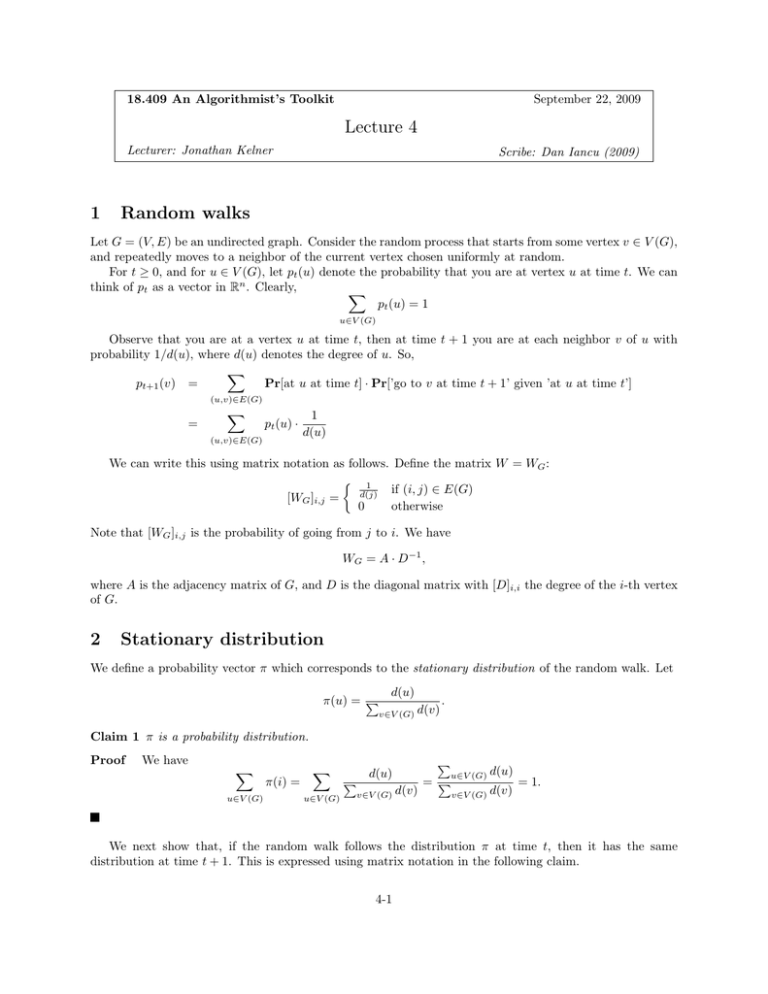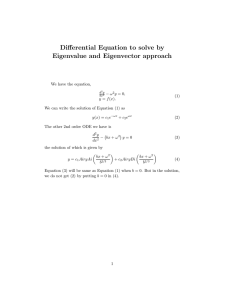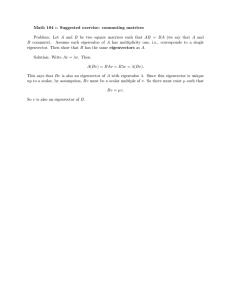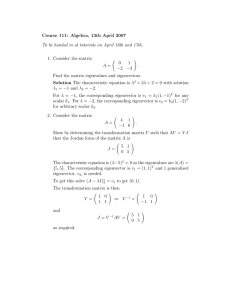Lecture 4 1 Random walks
advertisement

18.409 An Algorithmist’s Toolkit
September 22, 2009
Lecture 4
Lecturer: Jonathan Kelner
1
Scribe: Dan Iancu (2009)
Random walks
Let G = (V, E) be an undirected graph. Consider the random process that starts from some vertex v ∈ V (G),
and repeatedly moves to a neighbor of the current vertex chosen uniformly at random.
For t ≥ 0, and for u ∈ V (G), let pt (u) denote the probability that you are at vertex u at time t. We can
think of pt as a vector in Rn . Clearly,
X
pt (u) = 1
u∈V (G)
Observe that you are at a vertex u at time t, then at time t + 1 you are at each neighbor v of u with
probability 1/d(u), where d(u) denotes the degree of u. So,
X
pt+1 (v) =
Pr[at u at time t] · Pr[’go to v at time t + 1’ given ’at u at time t’]
(u,v)∈E(G)
=
X
pt (u) ·
(u,v)∈E(G)
1
d(u)
We can write this using matrix notation as follows. Define the matrix W = WG :
1
if (i, j ) ∈ E (G)
d(j)
[WG ]i,j =
0
otherwise
Note that [WG ]i,j is the probability of going from j to i. We have
WG = A · D−1 ,
where A is the adjacency matrix of G, and D is the diagonal matrix with [D]i,i the degree of the i-th vertex
of G.
2
Stationary distribution
We define a probability vector π which corresponds to the stationary distribution of the random walk. Let
π(u) = P
d(u)
v∈V (G)
d(v)
.
Claim 1 π is a probability distribution.
Proof
We have
X
u∈V (G)
π(i) =
P
u∈V (G)
P
d(u)
X
v∈V (G)
d(v)
u∈V (G)
d(u)
v∈V (G)
d(v)
= P
= 1.
We next show that, if the random walk follows the distribution π at time t, then it has the same
distribution at time t + 1. This is expressed using matrix notation in the following claim.
4-1
Claim 2 W · π = π.
Proof
Let k ∈ V (G). We have
[W · π]k =
n
�
i=1
Wk,i πi = �
�
1
v∈V (G)
d(v)
(i,k)∈E(G)
1
1
· d(k) = π(k).
· d(k) = �
d(k)
v∈V (G) d(v)
This statement is equivalent to the matrix W having eigenvalue 1, with corresponding eigenvector π
(note that, since π is a multiple of the vector of node degrees, D · 1, we could also take the latter as the
eigenvector).
The natural next step at this point would be to claim that the random walk of a graph G always converges
to the stationary distribution π. This however turns out to be false. It is easy to see that for a bipartite
graph G. Consider for example the case G = C6 , the cycle on 6 vertices, and let the vertex set of G be
V (G) = {1, 2, . . . , 6}. Assume without loss of generality that the random walk starts at time t0 = 1 at vertex
6. Then, at time t, the current vertex is odd if and only if t is odd. Therefore, the walk does not converge
to any distribution.
3
Lazy Random Walks
There is an easy way to fix the above periodicity problem. We introduce a modified version of the original
walk, which we call lazy random walk. In a lazy random walk at time t:
• we take a step of the original random walk with probability 1/2,
• we stay at the current vertex with probability 1/2.
We can show that the above modification breaks the periodicity of the random walk. The transition proba­
bilities are encoded in the following matrix:
W = (W + I)/2 = (I + A · D−1 )/2,
where I denotes the identity matrix.
The fact that W and W are not symmetric matrices makes their analysis complicated. We will thus
define new matrices. The normalized walk matrix is defined as
N = D−1/2 · W · D1/2 = D−1/2 · A · D−1/2 .
The normalized lazy walk matrix is defined as
N = D−1/2 · W · D1/2 = (I + D−1/2 · A · D−1/2 )/2.
Claim 3 The matrices N and W have the same eigenvalues and related eigenvectors.
Proof
Suppose that v is an eigenvector of N , with eigenvalue λ. Let q = D1/2 · v. Then,
N · v = λ · v = D−1/2 · W · D1/2 · v = D−1/2 · W · q.
Multiplying by D1/2 on the left we obtain
W · q = λ · D1/2 · v = λ · q.
Therefore, q is an eigenvector of W with eigenvalue λ.
Observe that, by Claim 2, W has eigenvector D · 1, with eigenvalue 1. Therefore, by Claim 3, the
normalized walk matrix N has eigenvector D1/2 · 1, with eigenvalue 1.
4-2
4
Connections to Laplacians
We’ve used the Laplacian L. The normalized Laplacian L is defined as
L = D−1/2 · L · D−1/2 .
Claim 4 N = I − L.
Therefore, the eigenvalues of N are given by 1 − (eigenvalues of L). So, it makes sense to order them in the
opposite way
1 = μ1 ≥ μ2 ≥ . . . ≥ μn
We can now translate our theorems about the eigenvalues of Laplacians to theorems about μi s. We have
• For each i, μi ∈ [−1, 1].
• If G is connected, then μ2 < 1.
• The −1 eigenvalues occur only for bipartite graphs.
Let μi be the eigenvalues of N . Then
• For each i, μi ∈ [0, 1].
• If G is connected, then μ2 < 1.
5
�2 Convergence
Define the spectral gap to be
λ := 1 − μ2 .
For probability distributions p, q, we define their 2 distance to be
��
p − q2 =
(p(i) − q(i))2 .
i
The following theorem gives a bound on the rate of convergence of the lazy random walk to the stationary
distribution π.
Theorem 5 Let p0 be an arbitrary initial distribution, and pt be the distribution after t steps of the lazy
random walk. Then,
�
maxx d(x)
t
.
pt − π2 ≤ (1 − λ) ·
miny d(y)
Proof [Proof for regular graphs] Observe that for a matrix M = Q−1 · Λ · Q, we have M k = Q−1 · Λk · Q.
Thus, for an eigenvector v of M , M k · v = λk · v.
Recall that N = (I + D−1/2 · A · D−1/2 )/2. Since G is regular, D = d · I, for some integer d > 0. Thus,
1
N = I + A
d
and the stationary distribution is simply the uniform distribution on V (G)
π=
1
· 1.
n
4-3
Let ci = viT p0 , where vi denotes the eigenvector corresponding to the i-th eigenvalue. We have
N k · p0 =
n
�
ci · μki · vi = c1 · v1 +
i=1
Since c1 = v1T p0 = 1/n, it follows that
pk − π2
=
n
�
ci · μki · vi
i=2
�
�
� n
� n
�
�
��
k
k�
2
2
k
�
ci · μi · vi 2 =
ci · μi ≤ μ2
c2i
i=2
i=2
≤ μk2
n
�
n
�
i=2
(viT p0 )2 ≤ μk2 = (1 − λ)k .
i=1
Using a similar argument, we can also show an analogous bound for ∞ convergence.
Theorem 6 For any vertex v ∈ V (G),
�
|pt (v) − π(v)| ≤ (1 − λ) ·
t
6
d(v)
miny d(y)
Conductance
Cheeger’s inequality carries over too, by replacing the isoperimetric number by a new parameter, which we
call conductance Φ.
Definition 7 (Conductance) For S ⊆ V (G), let
Φ(S) =
min
e(S)
�.
�
d(v),
v∈S
v∈S̄ d(v)
��
We define the conductance to be
Φ(G) = min Φ(S).
S⊆V
Using the above definition, Cheeger’s inequality now becomes:
Θ(1) · Φ2 (G) ≤ 1 − μ2 ≤ Θ(1) · Φ(G).
The parameter Φ(G) is related to the rate of convergence to the stationary distribution. In particular,
bounds on Φ(G) let us prove that a walk mixes quickly.
The intuitive interpretation of the connection between conductance and the rate of convergence is as
follows. If a graph has high conductance, it is well-connected. Therefore, a large amount of probability mass
can very quickly move from one part of the graph to another.
7
Introduction to Monte Carlo methods
Assume that we want to estimate π = 3.1415 . . . by throwing darts in the following dartboard:
4-4
Assume that the square corresponds to [−1, 1] × [−1, 1]. If you pick a point in the square uniformly at
random, the probability that you pick one inside the circle is equal to π/4. Suppose that you pick n points
in [−1, 1] × [−1, 1], uniformly at random. Then,
E[number of points inside circle] = n · π/4
So, you can return the estimate
π̂ = (number of points inside circle) · 4/n.
A natural question is how close this estimate would be to the right answer.
In order to answer the above question, we will introduce the Chernoff bound. Suppose we have a random
variable r ∈ {0, 1}, such that Pr[r
� = 1] = p, and Pr[r = 0] = 1 − p. Assume that we draw n independent
samples r1 , . . . , rn , and let R = i ri . By the linearity of expectation, we have
E[R] = E[
�
ri ] =
i
�
E[ri ] = n · p
i
We will say that R -approximates E[R] if
(1 − )E[R] ≤ R ≤ (1 + )E[R]
This is a multiplicative error measure.
Theorem 8 (One version of the Chernoff bound) The probability that R fails to -approximate E[R]
is
2
2
Pr [|R − E[R]| ≥ E[R]] ≤ 2e−np /12 = 2e−E[R] /12 .
Some notes on the above bound:
• The bound is near tight.
• It is necessary for the trials to be independent, in order for the bound to hold.
• It provides a multiplicative, but not an additive error guarantee.
• For fixed , it falls off exponentially in n. So, if we have failure probability 1/2, we can improve it to
1/2k by performing m = n · k trails.
• Therefore, smaller n requires more trials.
• If we want -approximation with probability 1 − δ, then we need
�
�
log(1/δ)
N ≥Θ
.
p2
That is, we need enough trials to get Θ(log(1/δ)/2 ) successes.
4-5
Back to the dartboard example, if we want to estimate π within, say, 5%, with probability at least 0.99,
then we have = 0.05, δ = 1/100. Therefore, we need
�
�
log(100)
N ≥Θ
(π/4)(0.05)2
Observe that it is easy to make δ smaller, but it is harder to make smaller.
If we are bad darts, then we run into trouble. This happens if we have a big dartboard, and a small
circle.
In particular, if p is exponentially small, then we need exponentially many trials to expect a constant number
of successes.
We can also run into trouble if it is hard to throw darts at all. That is, if it is hard to draw samples
uniformly at random from the ambient space. We will develop some techniques for fixing the above problems
in certain scenarios.
4-6
MIT OpenCourseWare
http://ocw.mit.edu
18.409 Topics in Theoretical Computer Science: An Algorithmist's Toolkit
Fall 2009
For information about citing these materials or our Terms of Use, visit: http://ocw.mit.edu/terms.






